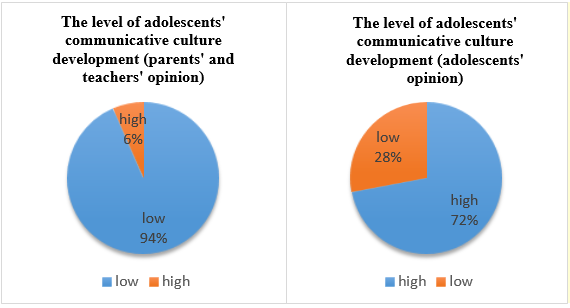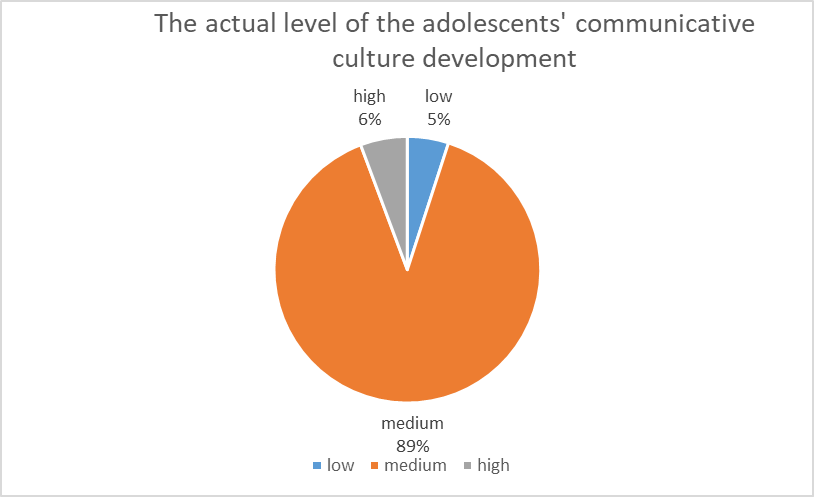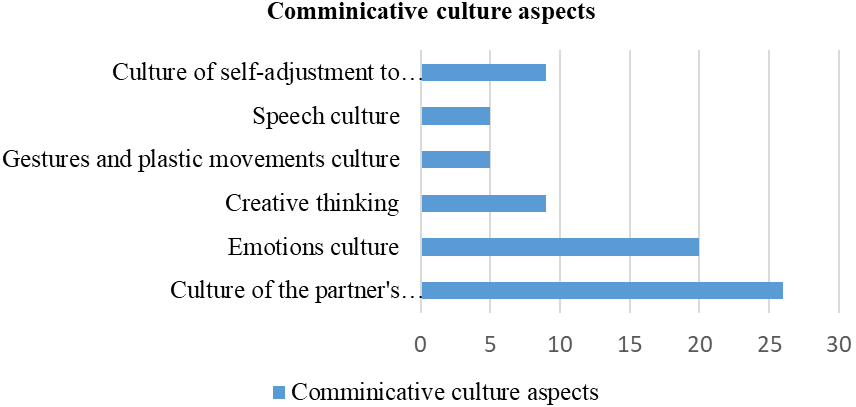Abstract
The article considers the concept of communicative culture, the peculiarities of the present adolescents’ communicative culture, the problem of the adolescents’ communicative culture development in the context of informatization and digitalization. The issues of the modern adolescents’ communicative culture transformation in the format of virtual communication are highlighted. The idea of a communicative culture among modern adolescents is determined. An informational approach and a sociocultural approach, which made it possible to study information sources used by modern adolescents, were used in the study. In the pilot study, the author used the interview and independent peer review methods. The results of a survey in the form of adolescents’, parents’ and teachers’ interview in order to identify their opinions on the level of the modern adolescents’ communicative culture development are presented. The results of the adult respondents’ and adolescents’ answers were compared, summarized and correlated with the results of an online survey, which made it possible to determine the real level of theadolescents’ communicative culture development. The influence of international educational exchange on the adolescents’ communicative culture is also analyzed. It has been established that international educational exchange has a positive effect on the adolescents’ communicative culture development and contributes to the development of the communicative culture certain aspects.
Keywords: Virtual communications, communication diagnostics, international educational exchange, communicative culture, interpersonal communication, communication styles
Introduction
Communication is the most important type of interaction between people, as well as one of the most important qualities of a modern person. The formation of an individual, success in social, personal and professional spheres largely depends on how effectively different individual’s communication styles are implemented in different situations (Tsyvunina, 2019).
Theoretical aspects of communicative culture are discussed in the following works: Andreeva et al. (2020), Makarova (2018), Gorovoy and Grigorova (2016), Bogdanova (2019), Mironova (2017), Alexandrova (2009), Zhikina (2018), Sviridova (2016) and other researchers. At the same time, certain differences can be noted both in the approaches to determining communicative culture and in the methods of its diagnosis (Chuckova, 2007).
The adolescents’ communicative culture largely reflects the main features of national and group communicative behavior, however, at the same time, it contains certain individual traits formed under the influence of hereditary factors, temperament, character, parenting style, intellectual and social development (Safonova, 2018).
In the modern world, information diversity is increasing, which is associated with increasing flows of various information, including scientific and educational ones, modern methods of obtaining and processing it, the significant influence of information sources on the way of thinking, worldview, the nature of interpersonal and intergenerational communication. Information diversity is a source of social, educational and communication systems development on the one hand, but it creates a large number of pedagogical problems on the other hand (Donina et al., 2018, p. 944).
The educational system today is changing due to the globalization and digitalization processes taking place in the world. Many scholars recognize the fact that modern society is migratory and open to accepting different cultures (Thimmel, 2010).
The internationalization of education extends to almost all aspects of education and covers all levels of educational programs, technologies, assessment and quality control systems. Internationalization is recognized worldwide as an important educational strategy (Pevzner et al., 2019).
International educational exchanges are becoming an important part of the education system, since there is an opinion that they help not only to improve communication and foreign language skills, but also increase their competitiveness in the labour market and to feel the difference between the state educational systems. Working with youth in partner countries is essential for the common concepts’ effective development, joint workshops and other events (Becker & Thimmel, 2019).
However, the phenomenon of international educational exchange today is not completely explored.
Problem Statement
Teachers and parents have faced the problem of the adolescents’ communicative culture development in the informatization and digitalization era, since today communication has changed due to the spread of virtual means of communication. Communication is becoming less real and more virtual.
The relevance of the problem of studying the adolescents’ communicative culture in the informatization era is relevant because:
- New communicative culture limits interpersonal communication and allows adolescents to immerse themselves in virtual space.
- Communicative culture today is very different from traditional communicative culture.
- At the moment, there is a need for the adolescents’ communicative culture development in the context of informatization and digitalization, and the theory of the adolescents’ communicative culture development and pedagogical tools has not been sufficiently developed.
This study also considers international educational exchange as a modern means of the adolescents’ communicative culture development. A study is being conducted on whether international educational exchange has an impact on the communicative culture formation; communicative culture aspects which an adolescent can develop through participation in international educational exchange programs are identified.
Research Questions
The article searches for answers to the following research questions:
Do adolescents consider their communicative culture sufficiently developed, and do they need to develop it?
Do the teachers’, parents’ and adolescents’ assessment of the level of the communicative culture development coincide?
Does educational exchange affect the modern adolescents’ communicative culture development?
Do today’s adolescents, teachers and parents find educational exchange useful?
What aspects of communicative culture does international educational exchange allow to develop?
Purpose of the Study
The main purpose of the study is to identify the benefits of international educational exchange and to determine communicative culture aspects which adolescents can develop through international educational exchange. The study also reveals the parents’, teachers’ and adolescents’ opinion about the level of the adolescents’ communicative culture development and determines the true level of the communicative culture development using an online survey. The results of the online survey are compared with the parents’, teachers’ and adolescents’ own opinions.
Research Methods
Within the framework of the study, an informational and sociocultural approach was used. The study used the technique of interviews and independent peer reviews.
For this, several focus groups were identified, consisting of parents, teachers and adolescents. These focus groups were asked the same questions about the level of the modern adolescents’ communicative culture development. 206 people took part in the interview, including 37 teachers, 67 parents and 102 adolescents.
Alongside with this survey, supported by the Goethe-Institut St. Petersburg, a survey of parents and teachers, whose children and students participated in international educational exchange programs, was conducted in order to identify its benefits as a means of adolescents’ communicative culture development. A survey was also conducted among the adolescents themselves. A total of 129 people took part in the survey.
Findings
At the beginning of the study, parents’, teachers’ and adolescents’ survey has been conducted regarding their opinion on the level of the modern adolescents’ communicative culture development. As a result of the survey, the teachers’ and parents’ opinions have been similar. 94% of respondents believe that the level of adolescents’ communicative culture is low. Only 6% of the respondents have expressed the opinion that the level of the modern adolescents’ communicative culture development is sufficiently developed.
However, the results of interviews with adolescents themselves have shown that adolescents consider their communicative culture to be sufficiently developed (72% of respondents).
To determine the actual level of the adolescents’ communicative culture development, a questionnaire has been developed, which has been sent to respondents through the “Vkontakte” social network. The questionnaire consisted of 20 questions. The survey has involved respondents aged 14 to 17 years.
According to the collected data, 6% of adolescents have a high degree of the communicative culture development, 89% of adolescents have a medium degree and 5% of adolescents have a low degree of the communicative culture development.
Research data are presented in Figures 01 and 02.


Within the framework of the “Vkontakte” social network study, with the support of the Goethe Institute of St. Petersburg and other social communities, an Internet survey of the adolescents who had participated in international educational exchange was conducted in order to identify the usefulness of educational exchange as a means of the adolescents’ communicative culture development.
The online survey has also identified the communicative culture aspects which the adolescents had developed by participating in educational exchange programs.
74 people have taken part in the survey. 97% of respondents believe that educational exchange affects the communicative culture development, 3% believe that it does not.
The respondents have also mentioned the following communicative culture aspects which they had been able to develop as a result of educational exchange:
- Culture of the partner’s communicative actions perception (26 respondents, 35.2%)
- Emotions culture (20 respondents, 27%)
- Creative thinking (9 respondents, 12.1%)
- Culture of self-adjustment to communication and regulation of one’s state (9 respondents, 12.1%)
- Speech culture (5 respondents, 6.8%)
- Gestures and plastic movements culture (5 respondents, 6.8%)
The research data are presented in Figure 03.

Alongside with this survey, a parents’ and teachers’ survey has been conducted in order to identify the benefits of educational exchange as a means of the adolescents’ communicative culture development.
55 people have taken part in the survey. 85.5% of parents and teachers have mentioned that the level of their children’s and students’ communicative culture had become higher after participating in the educational exchange program.
Conclusion
As a result of the study, it has been found that the adults’ (parents and teachers) and adolescents’ opinions regarding the level of the adolescents’ communicative culture development do not coincide. A discrepancy has also been found between the parents’, teachers’ and adolescents’ survey and the results of online testing. According to parents and teachers, the level of the modern adolescents’ communicative culture is very low, it needs to be developed. According to adolescents themselves, the level of their communicative culture development is quite high, so they do not feel the need for its further development. According to the results of online testing, it has been found that the majority of adolescents (89.3% of respondents) have a medium degree of their communicative culture development.
As a part of the study, it has been proven that international educational exchange has a positive effect on the adolescents’ communicative culture development and contributes to the development of the certain communicative culture aspects.
The adolescents’, parents’ and teachers’ opinions coincide since everyone mention the positive impact of international educational exchanges on the adolescents’ communicative culture.
References
Alexandrova, L. D. (2009). Kul’tura virtual’noy kommunikatsii [Virtual Communication Culture] (Doctoral dissertation). https://www.dissercat.com/content/kultura-virtualnoi-kommunikatsii
Andreeva, S. M., Andreeva, A. M., Bezuglova, O. V., & Shuen Wang (2020). Communicative culture as an integral part of communication. In N. R. Turavets, A. V. Skripkina, V. V. Kistenev (Eds.), Mnogourovnevaya sistema nepreryvnogo professional’nogo obrazovaniya v sociokul’turnoj sfere [Multilevel system of continuing professional education in the socio-cultural sphere] (pp. 34-41). BSUAC.
Becker, H., & Thimmel, A. (Eds.) (2019). Die Zugangsstudie zum internationalen Jugendaustausch. Zugänge und Barrieren [The access study to international youth exchange. Entrances and barriers]. Wochenschau Verlag, Schwalbach.
Bogdanova, L. I. (2019). Kontakt kul’tur i konflikt tsennostey v prepodavanii russkogo yazyka kak inostrannogo [Culture contact and valuesconflict in teaching russianas a foreignlanguage]. Scientific Journal “West –East”, 2/1(1), 139-143.
Chuckova, G. S. (2007). O problem obshcheniya v virtual’noy kommunikativnoy srede [The problem of communication in a virtual communicative environment]. Omskiy nauchnyy vestnik [Omsk Scientific Bulletin], 1(51), 90-94.
Donina, I., Pevzner, M., Petryakov, P., & Shaydorova, N. (2018). Pedagogical approach to information diversity management. In O. Titrek, A. Zembrzuska & G. Sezen-Gultekin (Eds.), The 4 International Conference on Lifelong Education and Leadership for all – ICLEL (pp. 784-791). Sakarya.
Gorovoy, V. I., & Grigorova, L. V. (2016). Kul’tura rechi kak component kommunikativnoy kul’tury i kommunikativnoy kompetentnosti yazykovoy lichnosti [Standard of speech as a component of communicative culture and communicative competence of the language personality]. Nauka i shkola [Science and School], 5, 153-157.
Makarova, E. N. (2018). Comprehension of written utterances’ communicative structure by Russian learners of English. The European Proceedings of Social & Behavioural Sciences, 39, 153-159.
Mironova, T. A. (2017). Vliyaniye kommunikativnoy kul’tury studenta na formirovaniye politicheskoy kul’tury molodezhi [The influence of the student’s communicative culture on the formation of the youth political culture]. Etnosotsium i mezhnatsional'nayakul'tura [Ethnic society and interethnic culture], 9(111), 40-46.
Pevzner, M. N., Petryakov, P. A., Donina, I. A., & Turkovskiy, V. I. (2019). Models and strategies of information diversity management. European Proceedings of Social and Behavioral Sciences EpSBS, 87, 56-64.
Safonova, V. V. (2018). Developing Russian PhD students’ academic culture in EAP courses for international communication and co-operation. European Journal of Interdisciplinary Studies, 4(2a), 103-114.
Sviridova, E. V. (2016). Inoyazychnaya kul’tura, natsional’noye kommunikativnoye povedeniye i korporativnaya kul’tura [Foreign language culture, national communication behavior and corporate culture]. In E. P. Komarova (Ed.), Inoyazychnaya kommunikativnaya kul’tura v povyshenii kachestva professional’noy podgotovki spetsialistov [Foreign language communicative culture in improving the quality of professional training of specialists] (pp. 166-168). Voronezh.
Thimmel, A. (2010). Internationale Jugendarbeit und kritische politische Bildung [International youth work and critical political education]. In B. Lösch & A. Thimmel (Eds.), Kritische politische Bildung. Ein Handbuch [Critical civic education. A manual] (pp. 497-508). Wochenschau Verlag.
Tsyvunina, A. D. (2019). The Communicative Culture of Adolescents in the Era of Informatization and Digitalization. European Proceedings of Social and Behavioral Sciences EpSBS, 87, 693-699.
Zhichkina, A. E. (2017). Sotsial’no-psikhologicheskiye aspekty obshcheniya v Internete [Socio-psychological aspects of communication on the Internet]. https://cyberpsy.ru/articles/zhichkina-online-obshhenie/
Copyright information

This work is licensed under a Creative Commons Attribution-NonCommercial-NoDerivatives 4.0 International License.
About this article
Publication Date
15 July 2021
Article Doi
eBook ISBN
978-1-80296-113-3
Publisher
European Publisher
Volume
114
Print ISBN (optional)
-
Edition Number
1st Edition
Pages
1-778
Subjects
Globalization, digital education, leadership, challenges of the time, оn-line pedagogy, universal and national values
Cite this article as:
Tsyvunina, A. (2021). International Educational Exchange As A Means Of An Adolescent’S Communicative Culture Development. In A. G. Shirin, M. V. Zvyaglova, O. A. Fikhtner, E. Y. Ignateva, & N. A. Shaydorova (Eds.), Education in a Changing World: Global Challenges and National Priorities, vol 114. European Proceedings of Social and Behavioural Sciences (pp. 594-601). European Publisher. https://doi.org/10.15405/epsbs.2021.07.02.71

